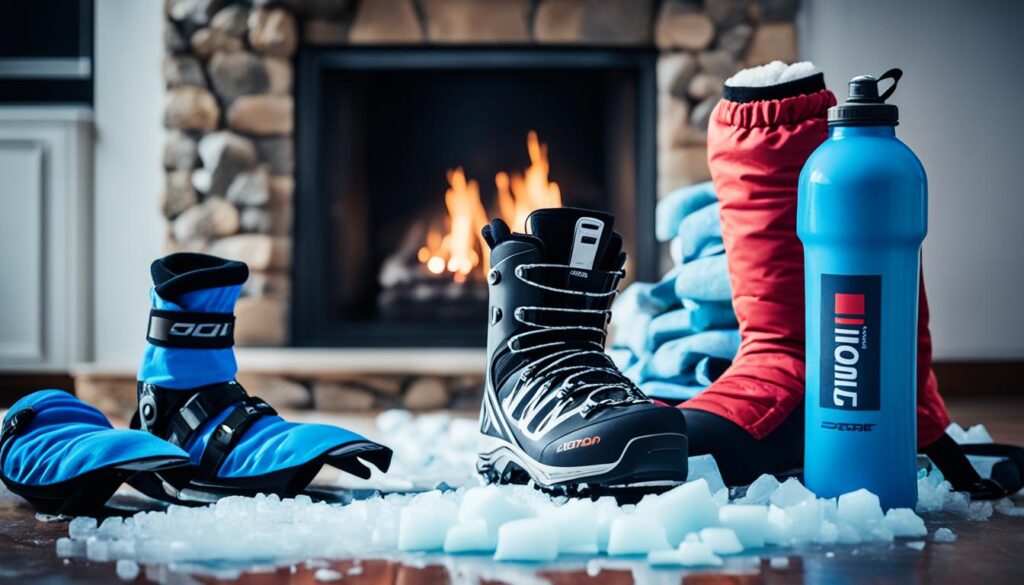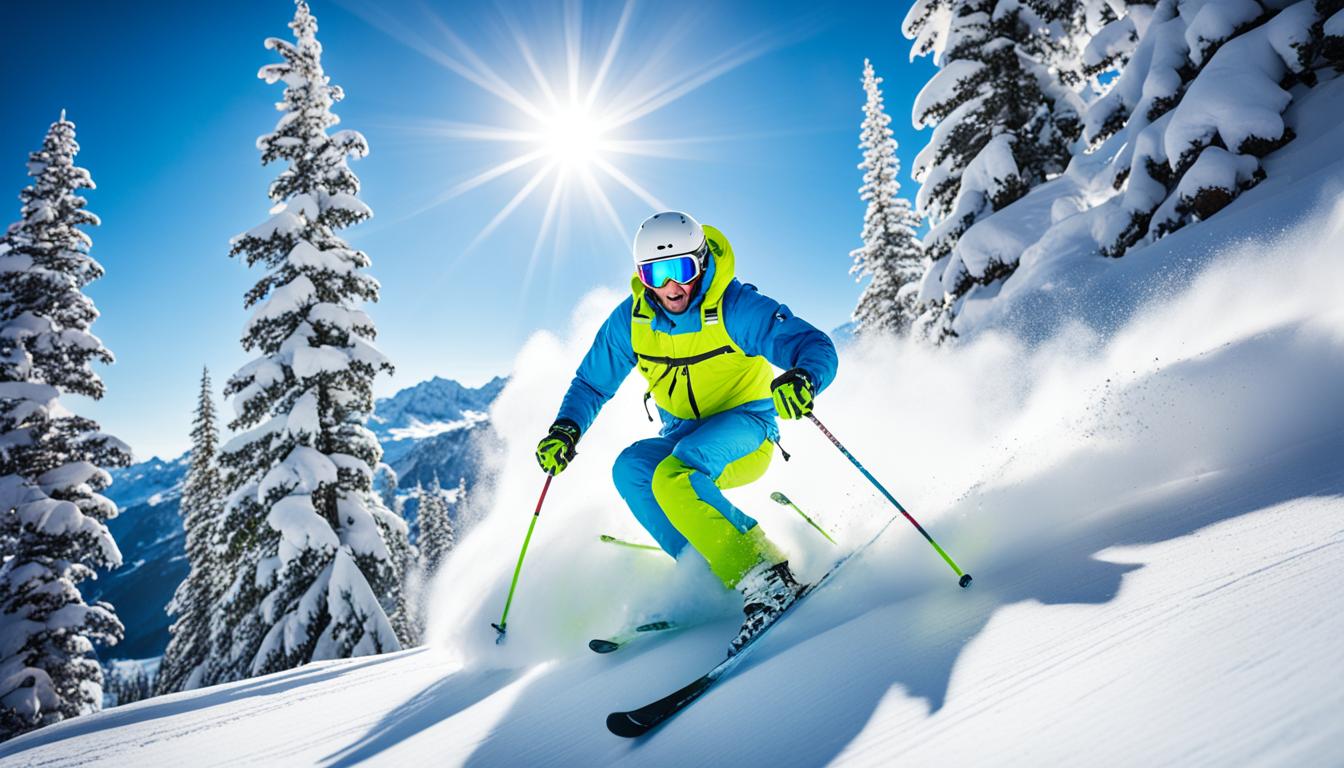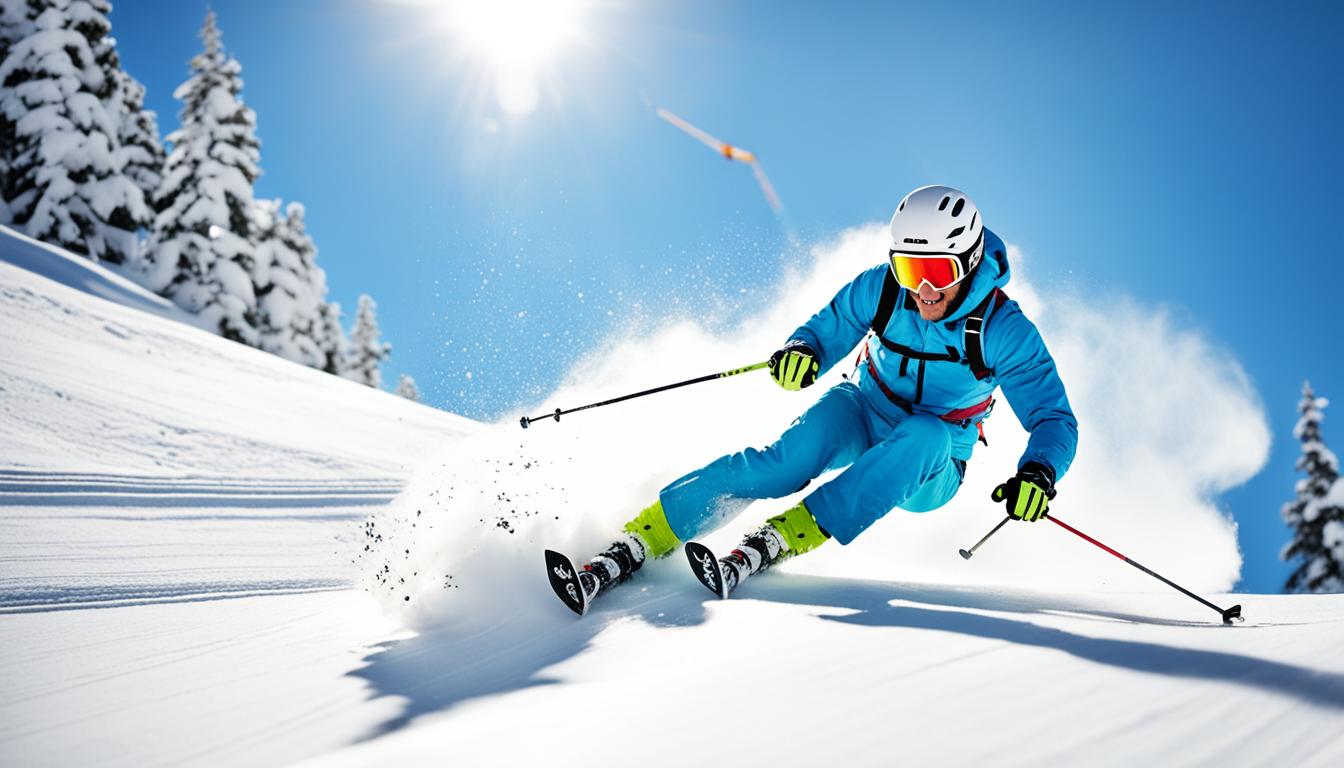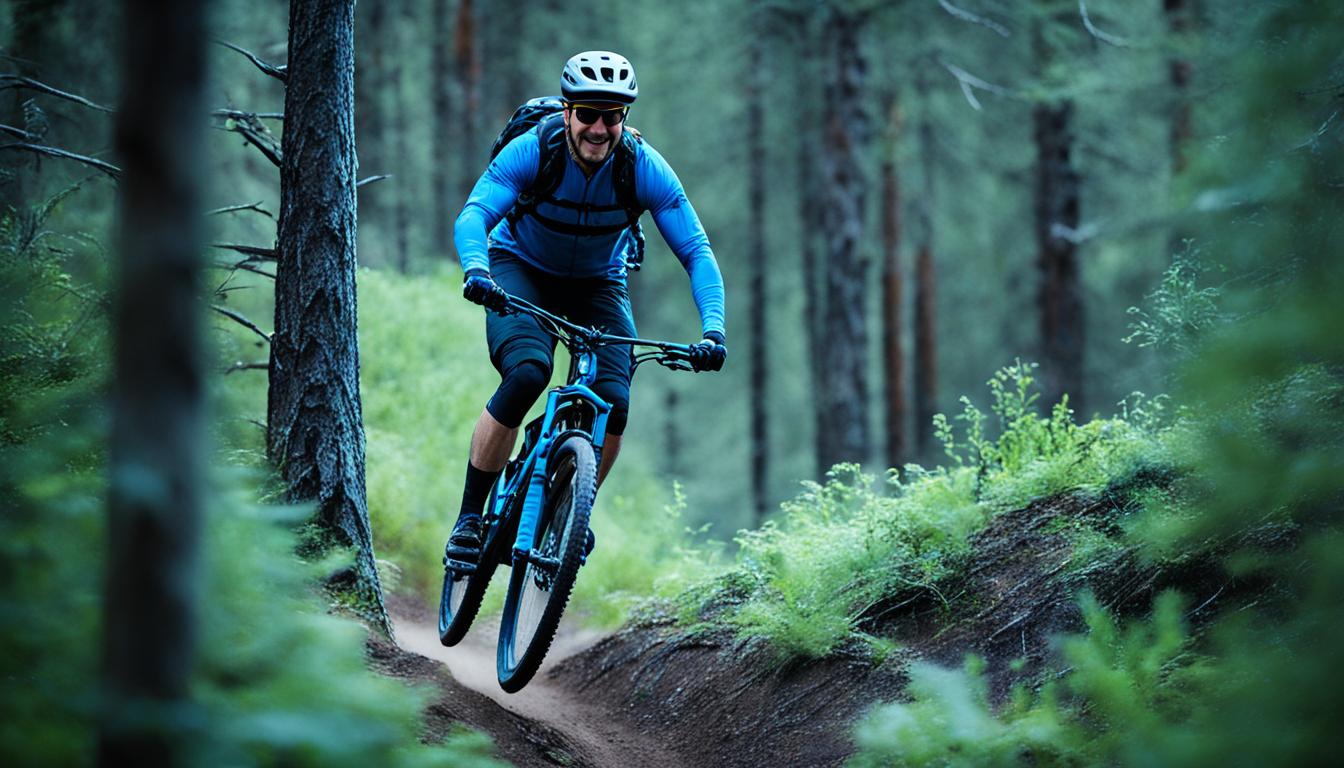After your first day of skiing, it’s time to take the next steps towards becoming a more proficient skier. Whether you’re a beginner who has just completed your first lesson or someone who has ventured out on the slopes for the first time, we’re here to help you continue improving your skiing skills.
From equipment tips to technique advice, we’ve got you covered. So, let’s dive in and discover what you can do after your first day to take your skiing abilities to new heights.
Key Takeaways:
- Be prepared with the right gear for your next ski lesson.
- Consider booking your lesson during the early or late season to take advantage of lower prices.
- Expect to continue building on the basics learned in your first lesson.
- Focus on building confidence and advancing at your own pace.
- Take care of your body by stretching and recovering after each ski day.
What to Bring for Your Next Ski Lesson
When preparing for your next ski lesson, it’s important to come prepared with the right gear. In addition to your ski attire, make sure to bring hand warmers and toe warmers to combat the cold temperatures. A comfortable pair of shoes for walking to the rental desk is also essential. Don’t forget to pack sunblock and chapstick with SPF to protect your skin from the winter sun. Your lesson will provide the necessary equipment, including skis, boots, and poles. However, consider adding a helmet for added safety.
Here’s a checklist of what to bring:
- Ski attire
- Hand warmers and toe warmers
- Comfortable shoes for walking
- Sunblock and chapstick with SPF
- Optional: Helmet for added safety
Being properly prepared for your ski lesson ensures that you can focus on improving your skills and enjoying the slopes to the fullest. Don’t forget to check the weather conditions and dress accordingly. Now, let’s take a look at when is the best time to book your next lesson.
When to Book Your Next Lesson
To optimize your ski lesson experience, it’s important to choose the right time to book. Consider scheduling your lesson during the early or late season when lesson prices are typically more affordable. However, keep in mind that certain beginner sections of the mountain may not be open during these times. To get a taste of the beginning of the season, we recommend booking your first lesson in early December.
Before booking, think about your physical ability and preference for lesson duration. Ski resorts typically offer both half-day and full-day lessons. Choose the option that aligns with your goals and allows you to make the most of your time on the slopes.
| Time of Year | Availability | Lesson Prices |
|---|---|---|
| Early Season (December) | Beginner sections may be limited | Lessons are often more affordable |
| Mid-Season (January – February) | Widest availability of lessons | Regular lesson prices |
| Late Season (March – April) | Conditions may become slushy | Lessons are often more affordable |
By carefully considering the ski season, lesson availability, and your personal preferences, you can make the best choice for your next ski lesson booking.
What to Expect in Your Next Lesson
In your next ski lesson, we’ll continue building on the basics you learned on your first day. Our goal is to help you progress and gain more confidence on the slopes. Whether you’re a beginner or have had some previous experience, our expert instructors will guide you through exercises that focus on important aspects of skiing, such as balance, movement, and steering.
You’ll have the opportunity to learn alongside a group of other beginners, creating a supportive and encouraging environment. Interacting with fellow skiers at similar skill levels can be motivating and enjoyable. Together, we’ll navigate the slopes, learn from each other’s experiences, and celebrate each small victory.
During the lesson, we’ll start on gentle slopes, gradually introducing you to more challenging terrain as you progress. This gradual increase in difficulty allows you to build up your skills and confidence step by step. By the end of the lesson, you’ll have a solid foundation to tackle larger hills with ease.
Exercises for Skill Development
Throughout the lesson, we’ll focus on various ski exercises to help you improve your technique and overall skiing ability. These exercises are designed to enhance your balance, control, and coordination. Here are a few examples of the exercises you can expect:
- Weight shifting: Learn how to distribute your weight between your skis to maintain stability and control.
- Edging drills: Practice using the edges of your skis to initiate turns and maintain control on different types of terrain.
- Turning exercises: Master the art of making smooth and controlled turns, adjusting your technique based on the terrain and speed.
- Pole planting: Understand the role of pole planting in maintaining balance and rhythm while skiing.
Each exercise is carefully selected to address specific skills and challenges that beginners often face. Our instructors will provide individualized guidance and feedback to help you improve your technique and build confidence.
| Benefits of Ski Exercises | Examples of Ski Exercises |
|---|---|
| Improves balance and stability | Weight shifting exercises |
| Enhances control and coordination | Edging drills |
| Aids in mastering turns | Turning exercises |
| Develops pole planting technique | Pole planting practice |
By actively participating in these exercises and focusing on proper technique, you’ll quickly notice improvements in your skiing skills. Remember to practice at your own pace and take advantage of the supportive environment and expert guidance provided by our instructors.
Remember, skiing is all about balance, control, and having fun. Embrace the learning process and enjoy every moment on the slopes. Don’t be afraid to challenge yourself and step out of your comfort zone – that’s where progress happens! We’re here to support you every step of the way.
So get ready for your next lesson and prepare to have a blast while honing your skiing skills. See you on the slopes!
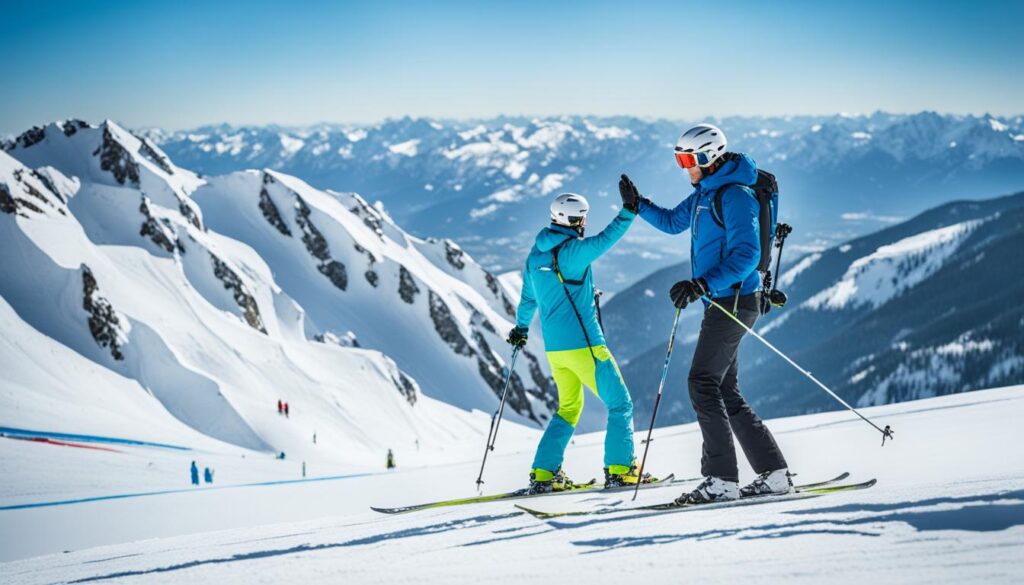
Building Confidence and Advancing in Skiing
After your lesson, it’s crucial to leave the mountain feeling confident. Our ski progression guide will help you advance your skills and build the confidence you need to tackle more challenging terrain. Remember, skiing is a sport that requires patience and practice, so avoid comparing your progress to others and focus on your own journey.
“Progression in skiing is all about taking small steps and celebrating each achievement along the way.”
Start by skiing on easy runs to warm up and get a feel for the snow conditions. This will help you regain your comfort and control before moving on to more difficult slopes. As you become more comfortable, gradually push yourself to try steeper runs and different types of terrain, such as moguls or glades.
Don’t hesitate to consult additional resources or guides for beginners. They can provide valuable tips and techniques to help you improve your skills and explore new areas of the mountain. Remember, skiing is not only about conquering the slopes but also about enjoying the journey and the beautiful surroundings.
Building Confidence Tips:
- Practice proper technique, such as maintaining a forward stance and bending your knees.
- Take breaks when needed to prevent fatigue and maintain focus.
- Set achievable goals and celebrate your progress along the way.
- Consider taking lessons or clinics to refine your skills and gain personalized feedback.
- Join a ski club or group to ski with like-minded individuals and share experiences.
| Advancing in Skiing | Benefits |
|---|---|
| Consistent practice and skills development | – Increased confidence and enjoyment on the slopes |
| Pushing boundaries and trying new challenges | – Sense of accomplishment and personal growth |
| Exploring different types of terrain | – Enhanced appreciation of nature and mountain scenery |
| Developing a lifelong passion for skiing | – Opportunities for adventure and shared experiences with friends and family |
Recovering and Preparing for the Next Ski Day
Skiing can be a thrilling and exhilarating experience, but it can also leave you with sore muscles and fatigue. To ensure you’re ready for your next ski day, it’s essential to prioritize post-ski recovery. By following a few simple steps, you can help your muscles recover, reduce soreness, and prepare for another day of skiing.
Post-Ski Stretches
One of the best ways to aid in ski recovery is to incorporate post-ski stretches into your routine. Stretching helps lengthen and loosen tight muscles, alleviating soreness and preventing stiffness. Focus on stretching your hamstrings, calves, shoulders, quads, and hips. Hold each stretch for 30 seconds and repeat 2-3 times. Here are a few stretches to get you started:
- Hamstring Stretch: Sit on the ground with one leg extended in front of you. Bend the other leg and place the sole of your foot against your inner thigh. Reach forward and try to touch your toes, feeling the stretch in the back of your extended leg.
- Quad Stretch: Stand with one hand against a wall for support. Bend one knee and bring your foot up towards your glutes. Grasp your foot with your hand and gently pull it towards your glutes, feeling the stretch in the front of your thigh.
- Calf Stretch: Stand facing a wall and place your hands on the wall for support. Step one foot back, keeping it straight and press the heel into the ground. Lean forward, feeling the stretch in your calf muscle.
Remember to perform these stretches with proper form and avoid bouncing or jerking movements, as this can lead to injury.
Hydration and Nutrition
Staying hydrated is crucial for both muscle recovery and overall well-being. Skiing is a physically demanding activity, and dehydration can exacerbate muscle soreness. Drink plenty of water throughout the day, both on and off the slopes, to replenish fluids and flush out toxins.
In addition to hydration, pay attention to your nutrition. Consuming a balanced diet rich in protein, healthy fats, and carbohydrates will provide the necessary nutrients to support muscle recovery. Incorporate foods such as lean meats, fish, fruits, vegetables, whole grains, and nuts into your meals. Consider adding a post-ski snack that combines protein and carbohydrates, such as a banana with peanut butter or a Greek yogurt with granola.
Relaxation Techniques
Relaxation techniques can also aid in ski recovery by reducing muscle tension and promoting relaxation. Consider soaking in a hot tub or sauna after skiing to increase circulation and relieve muscle soreness. The heat will help relax your muscles and improve blood flow, facilitating the recovery process.
If you don’t have access to a hot tub or sauna, you can still benefit from self-massage using a foam roller. Roll your muscles over the foam roller, applying gentle pressure to release any tension or knots. Focus on areas that feel particularly tight or sore, such as your calves, thighs, and back.
Lastly, consider booking a massage with a certified massage therapist. A professional massage can target specific areas of soreness and enhance muscle recovery. The therapist will use various techniques to knead and manipulate your muscles, promoting relaxation and reducing tension.
By incorporating these post-ski recovery practices into your routine, you’ll help your muscles recover faster, reduce soreness, and be better prepared for your next ski day. Remember, taking care of your body is just as important as challenging yourself on the slopes!
Conclusion
Congratulations on taking the next steps in your skiing journey! By following our tips and advice, you’ll continue to progress and build confidence on the slopes. Remember, skiing is not only an exhilarating adventure but also an opportunity to improve your ski skills while enjoying the winter season.
To make the most of your skiing adventure, it’s important to stay fit year-round. Engaging in activities that strengthen your core and lower body will help enhance your balance and control on the slopes.
Before hitting the slopes, don’t forget to warm up properly to prevent any injuries. Perform dynamic stretches and exercises that target your leg muscles, such as lunges or leg swings. Starting your skiing day with loose, warmed-up muscles will not only improve your performance but also reduce the risk of strains or sprains.
After a day of skiing, take time to prioritize recovery. Stretching your muscles will help alleviate any soreness or tightness. Hydration is key to replenishing your body after physical activity, so make sure to drink plenty of water throughout the day. Relaxation techniques, such as soaking in a hot tub or practicing deep breathing, can also aid in muscle recovery and rejuvenation.
With practice and determination, you’ll continue to improve your ski skills and truly enjoy the ski season. Embrace the joy of winter adventure, explore new slopes, and celebrate your progress along the way. Happy skiing!
FAQ
What should I bring for my next ski lesson?
It’s important to come prepared with the right gear. In addition to your ski attire, make sure to bring hand warmers and toe warmers to combat the cold temperatures. A comfortable pair of shoes for walking to the rental desk is also essential. Don’t forget to pack sunblock and chapstick with SPF to protect your skin from the winter sun. Your lesson will provide the necessary equipment, including skis, boots, and poles. However, consider adding a helmet for added safety.
When is the best time to book my next ski lesson?
Consider booking during the early or late season when lessons are typically cheaper. However, keep in mind that certain beginner sections of the mountain may not be open during these times. It’s recommended to schedule your first lesson in early December to get a taste of the season’s beginning. Choose between a half-day or full-day lesson, depending on your preference and physical ability.
What can I expect in my next ski lesson?
In your next ski lesson, you’ll continue building on the basics learned in your first day. The group size may vary, but be prepared to learn alongside other beginners. The instructor will guide you through exercises that focus on balance, movement, and steering. Starting on gentle slopes, you’ll gradually progress to more challenging terrain. Practice at your own pace and take advantage of the opportunity to gain confidence on the bunny slope before tackling larger hills.
How can I build confidence and advance in skiing?
After your lesson, it’s crucial to leave the mountain feeling confident. Avoid pushing yourself too far by starting with easy runs and gradually progressing to more difficult terrain. Remember that skiing is a sport that requires patience and practice. Don’t compare yourself to others and focus on your own progress. Consult additional resources or guides for beginners to continue building your skills and exploring new areas of the mountain.
How can I recover and prepare for the next ski day?
Skiing can be physically demanding, resulting in sore muscles after a day on the slopes. To aid in recovery, it’s important to stretch your muscles after skiing. Focus on stretching your hamstrings, calves, shoulders, quads, and hips. Hydration is key to combating muscle soreness, so drink plenty of water throughout the day. Consider soaking in a hot tub or sauna to increase circulation and relax your muscles. If possible, book a massage or use a foam roller for self-massage to alleviate any pain or tension.
How can I improve my skiing skills and enjoy the ski season?
Congratulations on taking the next steps in your skiing journey! By following the tips and advice in this guide, you’ll continue to progress and build confidence on the slopes. Remember to stay fit year-round, warm up before skiing, and start slow to avoid injuries. After your ski day, prioritize recovery with stretches, hydration, and relaxation techniques. With practice and determination, you’ll be able to enjoy the exhilarating experience of skiing to its fullest. Keep exploring new slopes and embracing the joy of winter adventure. Happy skiing!


